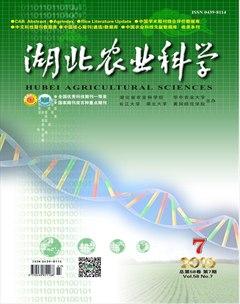加工工艺对石榴叶茶酚类物质及挥发性成分的影响
张卜升 李铁柱 成妮妮



摘要:采用分光光度法、高效液相色谱(HPLC)法分析茶样中的酚类物质,通过气相色谱-质谱联用(GC-MS)法分析茶样中的挥发性成分,并以龙井、正山小种和铁观音茶叶作为石榴叶绿茶、红茶和乌龙茶的对照。结果表明,石榴叶绿茶、红茶和乌龙茶总酚含量分别为156.73、137.44和123.10 mg/g,均高于相应的对照;各茶样鞣花酸含量相差不大,均保持在2.11~2.39 mg/g;石榴绿茶、红茶和乌龙茶的儿茶素含量分别为6.02、1.49和7.01 mg/g,均低于相应对照,其中石榴叶红茶的儿茶素含量最低仅为正山小种的26%;从石榴叶绿茶、红茶和乌龙茶中分别鉴定出26、33和34种挥发性成分,独有成分分别为3、5和8种。表明不同加工工艺对石榴叶茶的酚类物质含量及挥发性成分影响显著,与绿茶相比石榴叶红茶及乌龙茶的总酚含量均显著减少,涩味减轻;石榴叶红茶和乌龙茶中挥发性成分种类更多,并具有更丰富的特有成分,从而形成了不同工艺的特有香气类型。
关键词:石榴叶茶;酚类物质;挥发性成分;加工工艺
中图分类号:S571.1 文献标识码:A
文章编号:0439-8114(2019)07-0099-06
Abstract: The contents of phenolic compounds in the samples were measured using spectrophotometry and high performance liquid chromatography(HPLC) method, and the volatile components was analyzed by gas chromatography-mass spectrometry (GC-MS) method, in addition Longjing, Zhengshanxiaozhong and Tieguanyin tea as control of green tea, red tea and oolong tea. The results showed that total phenolic contents of pomegranate green tea, red tea and oolong tea are 156.73, 137.44 and 123.1 mg/g respectively, and higher than those of the control; the ellagic acid contents of samples have little difference, maintaining at 2.11~2.39 mg/g; the catechin contents of them are 6.02, 1.49 and 7.01 mg/g respectively, and lower than the corresponding control, especially that of the red tea is the lowest only 26% of Zhengshanxiaozhong. 26, 33 and 34 kinds of volatile components were identified from pomegranate green tea, red tea and oolong tea, and with 3, 5 and 8 kinds of unique ingredients respectively. It is suggested that the effects of different processing technology on the contents of phenolic compounds and volatile components of pomegranate leaf tea are significant, comparing with pomegranate green tea, total phenolic content of red tea and oolong tea reduced significantly and the tea astringency decreased. The volatile component species of pomegranate red tea and oolong tea are more than green tea, and with more rich special elements, thus forming unique aroma types of different technology.
Key words: pomegranate leaf tea; phenolic substances; volatile components; processing technology
石榴(Punica granatum L.)原产中西亚地区,古人誉之“天下之奇树,果中之极品”。《图经本草》载:“榴叶者,治咽喉燥渴,止下痢漏精,消食祛火”[1]。石榴叶中含有丰富的生物活性物质,包括酚类、黄酮及三萜类等[2-4],尤以多酚含量最高[5,6]。研究表明,多酚具有抗氧化[7,8]、抗衰老、抗癌防癌[9,10]、抗菌、润肤美容、降血压和预防心脑血管疾病[11]等功效。经现代科学鉴定,石榴叶含β-谷甾醇、槲皮素、石榴酸等[12],并含多种挥发油及微量元素,具有助消化、健胃怡神、促进代谢等功效[13],对人体起到一定的保健功能。山东省枣庄市峄城区作为中国著名的“中国石榴之乡”,石榴栽培历史悠久,栽培面积大,品种多样,有巨大的开发潜力。石榴叶可以加工成茶叶供饮用,石榴绿茶与红茶中酚类物质及抗氧化活性存在较大差别[14],但对不同工艺加工的石榴叶茶酚类物质及挥发性成分的比较研究鲜有报道。本试验以传统的龙井、正山小种和铁观音3种茶叶为对照,探索绿茶、红茶及乌龙茶3种加工工艺对石榴叶茶中酚类物质及挥发性成分的影响,為筛选石榴叶茶适宜的加工工艺提供依据,为科学开发石榴叶资源提供参考。

